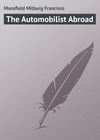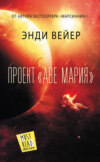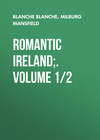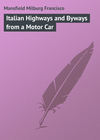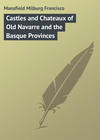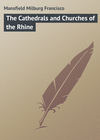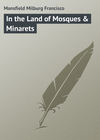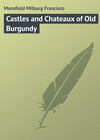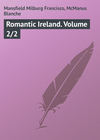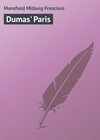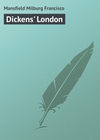Czytaj książkę: «The Automobilist Abroad»
Part I
General Information – The Grand Tour
Chapter I
An Appreciation of the Automobile
We have progressed appreciably beyond the days of the old horseless carriage, which, it will be remembered, retained even the dashboard.
To-day the modern automobile somewhat resembles, in its outlines, across between a decapod locomotive and a steam fire-engine, or at least something concerning the artistic appearance of which the layman has very grave doubts.
The control of a restive horse, a cranky boat, or even a trolley-car on rails is difficult enough for the inexperienced, and there are many who would quail before making the attempt; but to the novice in charge of an automobile, some serious damage is likely enough to occur within an incredibly short space of time, particularly if he does not take into account the tremendous force and power which he controls merely by the moving of a tiny lever, or by the depressing of a pedal.
Any one interested in automobiles should know something of the literature of the subject, which, during the last decade, has already become formidable.
In English the literature of the automobile begins with Mr. Worby Beaumont's Cantor Lectures (1895), and the pamphlet by Mr. R. Jenkins on "Power Locomotion on the Highways," published in 1896.
In the library of the Patent Office in London the literature of motor road vehicles already fills many shelves. The catalogue is interesting as showing the early hopes that inventors had in connection with steam as a motive power for light road vehicles, and will be of value to all who are interested in the history of the movement or the progress made in motor-car design.
In France the Bibliothèque of the Touring Club de France contains a hundred entries under the caption "Automobiles," besides complete files of eleven leading journals devoted to that industry. With these two sources of information at hand, and aided by the records of the Automobile Club de France and the Automobile Club of Great Britain and Ireland, the present-day historian of the automobile will find the subject well within his grasp.
There are those who doubt the utility of the automobile, as there have been scoffers at most new things under the sun; and there have been critics who have derided it for its "seven deadly sins," as there have been others who have praised its "Christian graces." The parodist who wrote the following newspaper quatrain was no enemy of the automobile in spite of his cynicism.
"A look of anguish underneath the car,
Another start; a squeak, a grunt, a jar!
The Aspiration pipe is working loose!
The vapour can't get out! And there you are!"
"Strange is it not, that of the myriads who
Have Empty Tanks and know not what to do,
Not one will tell of it when he Returns.
As for Ourselves, why, we deny it, too."
The one perfectly happy man in an automobile is he who drives, steers, or "runs the thing," even though he be merely the hired chauffeur. For proof of this one has only to note how readily others volunteer to "spell him a bit," as the saying goes. Change of scene and the exhilaration of a swift rush through space are all very well for friends in the tonneau, but for real "pleasure" one must be the driver. Not even the manifold responsibilities of the post will mar one's enjoyment, and there is always a supreme satisfaction in keeping one's engine running smoothly.
"Nothing to watch but the road," is the general motto for the automobile manufacturer, but the enthusiastic automobilist goes farther, and, for his motto, takes "stick to your post," and, in case of danger, as one has put it, "pull everything you see, and put your foot on everything else."
The vocabulary of the automobile has produced an entirely new "jargon," which is Greek to the multitude, but, oh, so expressive and full of meaning to the initiated.
An automobile is masculine, or feminine, as one likes to think of it, for it has many of the vagaries of both sexes. The French Academy has finally come to the fore and declared the word to be masculine, and so, taking our clue once more from the French (as we have in most things in the automobile world), we must call it him, and speak of it as he, instead of her, or she.
That other much overworked word in automobilism, chauffeur, should be placed once for all. The driver of an automobile is not really a chauffeur, neither is he who minds and cares for the engine; he is a mécanicien and nothing else – in France and elsewhere. We needed a word for the individual who busies himself with, or drives an automobile, and so we have adapted the word chauffeur. Purists may cavil, but nevertheless the word is better than driver, or motor-man (which is the quintessence of snobbery), or conductor.
The word, chauffeur, the Paris Figaro tells us, was known long before the advent of automobiles or locomotives. History tells that about the year 1795, men strangely accoutred, their faces covered with soot and their eyes carefully disguised, entered, by night, farms and lonely habitations and committed all sorts of depredations. They garroted their victims, or dragged them before a great fire where they burned the soles of their feet, and demanded information as to the whereabouts of their money and jewels. Hence they were called chauffeurs, a name which frightened our grandfathers as much as the scorching chauffeur to-day frightens our grandchildren.
A motor-car is a fearsome thing, – when it goes, it goes; and when it doesn't, something, or many things, are wrong. A few years ago this uncertainty was to be expected, for, though the makers will not whisper it in Gath, we are only just getting out of the bone-shaker age of automobiles.
Every one remembers what a weirdly ungraceful thing was the first safety bicycle, and so was the gaudy painted-up early locomotive – and they are so yet on certain English lines where their early Victorian engines are like Kipling's ocean tramp, merely "puttied up with paint." So with the early automobiles, they jarred and jerked and stopped – that is, under all but exceptional conditions. Occasionally they did wonderful things, – they always did, in fact, when one took the word of their owners; but now they really do acquit themselves with credit, and so the public, little by little, is beginning to believe in them, even though the millennium has not arrived when every home possesses its own runabout.
All this proves that we are "getting there" by degrees, and meantime everybody that has to do with motor-cars has learned a great deal, generally at somebody else's expense.
To-day every one "motes," or wants to, and likewise a knowledge of many things mechanical, which had heretofore been between closed covers, is in the daily litany of many who had previously never known a clutch from a cam-shaft, or a sparking plug from a fly-wheel.
Most motor enthusiasts read all the important journals devoted to the game. The old-stager reads them for their hints and suggestions, – though these are bewildering in their multiplicity and their contradictions, – and the ladies of the household look at them for the sake of their pretty pictures of scenery and ladies and veils and furry garments pertaining to the sport.
Catalogues are another bane of the motorist's life. He may have just become possessed of the latest thing in a Mercédès (and paid an enhanced price for an early delivery), yet upon seeing some new make of car advertised, he will immediately send for a catalogue and prospectus, and make the most absurd inquiries as to what said car will or will not do.
Since the pleasures of motoring have found their champions in Kipling, Maeterlinck, and the late W. E. Henley, the delectable amusement has, besides entering the daily life of most of us, generously permeated literature – real literature as distinct from recent popular fiction; "The Lighting Conductor" and "The Princess Passes," by Mrs. Williamson, and more lately, "The Motor Pirate," by Mr. Paternoster. "A Motor Car Divorce" is the suggestive title of another work, – presumably fiction, – and one knows not where it may end, since "The Happy Motorist," a series of essays, is already announced.
A Drury Lane melodrama of a season or two ago gave us a "thrillin' hair-bre'dth 'scape," wherein an automobile plunged precipitately – with an all too-true realism, the first night – down a lath and canvas ravine, finally saving the heroine from the double-dyed villain who followed so closely in her wake.
The last entry into other spheres was during the autumn just past, when Paris's luxurious opera-house was given over to the fantastic revels of the ballet in an attempt to typify the apotheosis of the automobile. This was rather a rash venture in prognostication, for it may be easy enough to "apotheosize" the horse, but to what idyllic heights the automobile is destined to ultimately reach no one really knows.
The average scoffer at things automobilistic is not very sincerely a scoffer at heart. It is mostly a case of "sour grapes," and he only waits the propitious combination of circumstances which shall permit him to become a possessor of a motor-car himself. This is not a very difficult procedure. It simply means that he must give up some other fad or fancy and take up with this last, which, be it here reiterated, is no fad.
The great point in favour of the automobile is its sociability. Once one was content to potter about with a solitary companion in a buggy, with a comfortable old horse who knew his route well by reason of many journeys. To-day the automobile has driven thoughts of solitude to the winds. Two in the tonneau, and another on the seat beside you in front – a well-assorted couple of couples – and one may make the most ideal trips imaginable.
Every one looks straight ahead, there is no uncomfortable twisting and turning as there is on a boat or a railway train, and each can talk to the others, or all can talk at once, which is more often the case. It is most enjoyable, plenty to see, exhilarating motion, jolly company, absolute independence, and a wide radius of action. What mode of travel can combine all these joys unless it be ballooning – of which the writer confesses he knows nothing?
On the road one must ever have a regard for what may happen, and roadside repairs, however necessary, are seldom more than makeshifts which enable one to arrive at his destination.
If you break the bolt which fastens your cardan-shaft or a link of your side-chains, you and your friends will have a chance to harden your muscles a bit pushing the machine to the next village, unless you choose to wait, on perhaps a lonely road, for a passing cart whose driver willing, for a price, to detach his tired horse to haul your dead weight of a ton and a half over a few miles of hill and dale. This is readily enough accomplished in France, where the peasant looks upon the procedure as a sort of allied industry to farming, but in parts of England, in Holland, and frequently in Italy, where the little mountain donkey is the chief means of transportation, it is more difficult.
The question of road speed proves nothing with regard to the worth of an individual automobile, except that the times do move, and we are learning daily more and more of the facility of getting about with a motor-car. A locomotive, or a marine engine, moves regularly without a stop for far greater periods of time than does an automobile, but each and every time they finish a run they receive such an overhauling as seldom comes to an automobile.
In England the automobilist has had to suffer a great deal at the hands of ignorant and intolerant road builders and guardians. Police traps, on straight level stretches miles from any collection of dwellings, will not keep down speed so long as dangerous cobblestoned alleys, winding through suburban London towns, have no guardian to regulate the traffic or give the stranger a hint that he had best go slowly.
The milk and butchers' carts go on with their deadly work, but the police in England are too busy worrying the motorist to pay any attention.
Some county boroughs have applied a ten-mile speed limit, even though the great bulk of their area is open country; but twenty miles an hour for an automobile is far safer for the public than is most other traffic, regardless of the rate at which it moves.
Speed, so far as the bystander is concerned, is a very difficult thing to judge, and the automobilist seldom, if ever, gets fair treatment if he meets with the slightest accident.
Most people judge the speed of an automobile by the noise that it makes. This, up to within a few years, put most automobiles going at a slow speed at a great disadvantage, for the slower they went the noisier they were; but matters of design and control have changed this somewhat, and the public now protests because "a great death-dealing monster crept up silently behind – coming at a terrific rate." You cannot please every one, and you cannot educate a non-participating public all at once.
As for speed on the road, it is a variable thing, and a thing difficult to estimate correctly. Electric cars run at a speed of from ten to twenty-two miles an hour in England, even in the towns, and no one says them nay. Hansoms, on the Thames Embankment in London, do their regular fifteen miles an hour, but automobiles are still held down to ten.
The official timekeeper of the Automobile Club of Great Britain and Ireland took the following times (in 1905) in Piccadilly, one of the busiest, if not the most congested thoroughfare in London.

When one considers how difficult to control, particularly amid crowded traffic, a horse-drawn vehicle is, and how very easy it is to control an up-to-date automobile, one cannot but feel that a little more consideration should be shown the automobilist by those in authority.
The road obstructions, slow-going traffic which will not get out of one's way, carts left unattended and the like, make most of the real and fancied dangers which are laid to the door of the very mobile motor-car.
In Holland and Belgium dogs seem to be the chief road obstructions, or at least dangers, not always willingly perhaps, but still ever-present. In England it is mostly children.
In France not all the difficulties one meets with en route are willful obstructors of one's progress. In La Beauce the geese and ducks are prudent, in the Nivernais the oxen are placid, and in Provence the donkeys are philosophical; but in Brittany the horses and mules and their drivers take fright immediately they suspect the coming of an automobile, and in the Vendée the market-wagons, and those laden with the product of the vine, career madly at the extremities of exceedingly lusty examples of horse flesh to the pending disaster of every one who does not get out of the road.
Sheep and hens are everywhere that they ought not to be, and there seems no way of escaping them. One can but use all his ingenuity and slip through somehow. Dogs are bad enough and ought to be exterminated. They are the silliest beasts which one finds uncontrolled on the roadways. Children, of course, one defers to, but they are outrageously careless and very foolish at times, and in short are the greatest responsibility for the driver in the small towns of England and France. In France some effort is being made in the schools to teach them something about a proper regard for automobile traffic, and with good results; but no one has heard of anything of the sort being attempted in England.
Chapter II
Travel Talk
Touring abroad is nothing new, but, as an amusement for the masses, it has reached gigantic proportions. The introduction of the railroad gave it its greatest impetus, and then came the bicycle and the automobile.
With the railway as the sole means of getting about one was more or less confined to the beaten track of travel in Continental Europe, but the automobile has changed all this.
To-day, the Cote d'Azur, from St. Raphael to Menton, as well as the strip of Norman coast-line around Trouville, in summer, is scarcely more than a boulevard where the automobile tourist strolls for an hour as he does in the Bois. The country lying back and between these two widely separated points is becoming known, and even modern taste prefers the idyllic countryside to a round of the same dizzy conventions that one gets in season at Paris, London, or New York.
France is the land par excellence for automobile touring, not only from its splendid roads, but from the wide diversity of its sights and scenes, and manners and customs, and, last but not least, its most excellent hotels strung along its highways and byways like pearls in a collarette.
This is not saying that travel by automobile is not delightful elsewhere; certainly it is equally so in many places along the Rhine, in Northern Italy, and in England, where the chief drawback is the really incompetent catering of the English country hotel-keeper to the demands of the traveller who would dine off of something more attractive than a cut from a cold joint of ham, and eggs washed down with stodgy, bitter beer.
The bibliography of travel books is long, and includes many famous names in literature. Marco Polo, Froissart, Mme. de Sévigné, Taine, Bayard Taylor, Willis, Stevenson, and Sterne, all had opportunities for observation and made the most of them. If they had lived in the days of the automobile they might have sung a song of speed which would have been the most melodious chord in the whole gamut.
A modern writer must be more modest, however. He can hardly hope to attract attention to himself or his work by describing the usual sights and scenes. The most he can do is to set down his method of travel, his approach, and his departure, and, for example, to tell those who may come after that the great double spires of Notre Dame de Chartres are a beacon by land for nearly twenty kilometers in any direction, as he approaches them by road across the great plain of La Beauce, the granary of France, rather than give a repetition of the well-worn guidebook facts concerning them.
Chartres is taken as an example because it is one of those "stock" sights, before mentioned, which any itinerary coming within the scope of the grand tour is bound to include.
Almost the same phenomenon is true of Antwerp's lacelike spire, the great Gothic wonder of Cologne and, to a lesser extent, that of Canterbury in England; thus the automobilist en route has his beacons and landmarks as has the sailor on the seas.
Man is an animal essentially mobile. He moves readily from place to place and is not tied down by anything but ways and means and, perhaps, confinement at laborious affairs. Even in the latter case he occasionally breaks away for a more or less extended period, and either goes fishing in Canada, shooting in Scotland, or automobiling in France, with perhaps a rush over a Swiss pass or two, and a dash around the Italian lakes, and back down the Rhine for a little tour in Great Britain.
This is as delightful a holiday as one could imagine, and the foreign tour – which has often been made merely as a succession of nights of travel in stuffy sleeping-cars or a round of overfeeding orgies at Parisian hotels and restaurants – has added charms of which the generation before the advent of automobiles knew nought.
The question of comfortable travel is a never-ending one. The palanquin, the sedan-chair, the rickshaw, even the humble horse-drawn buggy have had their devotees, but the modern touring automobile has left them all far behind, whether for long-distance travel or promenades at Fontainebleau, in the New Forest or the Ardennes.
There is no question but that, when touring in an automobile, one has an affection for his steel-and-iron horse that he never felt for any other conveyance. The horse had some endearing qualities, no doubt, and we were bound to regard his every want; but he was only a part of the show, whereas the automobile, although it is nought but an inanimate combination of wheels and things, has to be humoured and talked to, and even cursed at times, in order to keep it going. But it works faithfully nevertheless, and never balks, at least not with the same crankiness as the horse, and always runs better toward night (this is curious, but it is a fact), which a horse seldom does. All the same an automobile is like David Balfour's Scotch advocate: hard at times to ken rightly – most of the time, one may say without undue exaggeration. Often an automobile is as fickle as a stage fairy, or appears to be, but it may be that only your own blind stupidity accounts for the lack of efficiency. Once in awhile an automobile gets uproariously full of spirits and runs away with itself, and almost runs away with you, too, simply for the reason that the carburetion is good and everything is pulling well. Again it is as silent and immovable as a sphinx and gives no hint of its present or expected ailments. It is most curious, but an automobile invents some new real or fancied complaint with each fresh internal upheaval, and requires, in each and every instance, an entirely new and original diagnosis.
With all its caprices, however, the automobile is the most efficient and satisfactory contrivance for getting about from place to place, for business or pleasure, that was ever devised.
Comparatively speaking, the railway is not to be thought of for a moment. It has all the disadvantages of the automobile (for indeed there are a few, such as dust and more or less cramped quarters, and, if one chooses, a nerve-racking speed) and none of its advantages, and, whether you are a mere man or a millionaire, you are tied down to rails and a strict itinerary, whereas you may turn the bonnet of your automobile down any by-road that pleases your fancy, and arrive ultimately at your destination, having made an enjoyable detour which would not otherwise have been possible.
Too great a speed undoubtedly detracts from the joy of travel, but a hundred and fifty, two hundred and fifty, or three hundred kilometres a day on the fine roads of France, or a hundred or a hundred and fifty miles on the leafy lanes of England's southern counties will give the stranger more varied impressions and a clearer understanding of men and matters than the touring of a country from end to end in express-trains which serve your meals en route, and whisk you from London to Torquay between tea and dinner, or from Paris to the Cote d'Azur between breakfast and nightfall.
Just how much pleasure and edification one can absorb during an automobile tour depends largely upon the individual – and the mood. Once the craving for speed is felt, not all the historic monuments in the world would induce one to stop a sweetly running motor; but again the other mood comes on, and one lingers a full day among the charms of the lower Seine from Caudebec to Rouen, scarce thirty miles.
Les Andelys-sur-Seine, your guide-book tells you, is noted for its magnificent ruins of Richard Cœur de Lion's Château Gaillard, and for the culture of the sugar-beet, and so, often, merely on account of the banal mention of beet-roots, you ignore the attractions of Richard's castle and make the best time you can Parisward by the great Route Nationale on the other side of the Seine. This is wrong, of course, but the mood was on, and the song of speed was ringing in your ears and nothing would drive it out.
Our fathers and grandfathers made the grand tour, in a twelvemonth, as a sort of topping-off to their early education, before they settled down to a business or professional life.
They checked off in their guide-books Melrose Abbey, the Tower of London, the Cathedral of Canterbury, and those of Antwerp, Cologne, Rome, Venice, and Paris, as they did the Cheshire Cheese, Mont Blanc, and the ruins of Carnac. It was all a part of the general scheme of travel, to cover a lot of ground and see all they could, for it was likely that they would pass that way but once. Why, then, should one blame the automobilist – who really travels very leisurely in that he sees a lot of the countryside manners and customs off the beaten track – if he rushes over an intermediate stretch of country in order to arrive at one more to his liking?
One sees the thing every day on any of the great highroads in France leading from the Channel ports. One's destination may be the Pyrenees, the Cote d'Azur, Italy, or even Austria, and he does the intermediate steps at full speed. The same is true if he goes to Switzerland by the Rhine valley, or to Homburg by passing through Belgium or Holland. He might be just as well pleased with a fortnight in the Ardennes, or even in Holland or in Touraine, but, if his destination is Monte Carlo or Biarritz, he is not likely to linger longer by the way than the exigencies of food, drink, and lodging, and the care of his automobile demand.
When he has no objective point he loiters by the way and no doubt enjoys it the more, but it is not fair to put the automobilist down as a scorcher simply because he is pushing on. The best guide-books are caprice and fantasy, if you are hot pressed for time.
Mile-stones, or rather bornes kilométriques, line the roadways of Continental military Europe mercilessly, and it's a bad sign when the chauffeur begins to count them off. All the same, he knows his destination a great deal better than does some plodding tourist by rail who scorns him for rushing off again immediately after lunch.
One of the charms of travel, to the tried traveller, is, just as in the time of the Abbé Prévost, the ability to exchange remarks on one's itinerary with one's fellow travellers. In France it does not matter much whether they are automobilists or not. The commis-voyageur is a more numerous class here, apparently, than in any other country on the globe, and the detailed information which he can give one about the towns and hotels and sights and scenes en route, albeit he is more familiar with travel by rail than by road, is marvellous in quantity and valuable as to quality.
The automobile tourist, who may be an Englishman or an American, has hitherto been catered to with automobile novels, or love stories, or whatever one chooses to call them, or with more or less scrappy, incomplete, and badly edited accounts of tours made by some millionaire possessor of a motor-car, or the means to hire one. Some of the articles in the press, and an occasional book, have the merit of having been "good stuff," but often they have gone wrong in the making.
The writer of this book does not aspire to be classed with either of the above classes of able writers; the most he would like to claim is that he should be able to write a really good handbook on the subject, wherein such topographical, historical, and economic information as was presented should have the stamp of correctness. Perhaps four years of pretty constant automobile touring in Europe ought to count for something in the way of accumulated pertinent information concerning hotels and highways and by-ways.
Not all automobilists are millionaires. The man of moderate means is the real giver of impetus to the wheels of automobile progress. The manufacturers of motor-cars have not wholly waked up to this fact as yet, but the increasing number of tourists in small cars, both in England and in France, points to the fact that something besides the forty, sixty, or hundred horse-power monsters are being manufactured.
Efficiency and reliability is the great requisite of the touring automobile, and, for that matter, should be of any other. Efficiency and reliability cover ninety-nine per cent. of the requirements of the automobilist. Chance will step in at the most inopportune moments and upset all calculations, but, with due regard given to these two great and fundamental principles, the rest does not much matter.
It is a curious fact that the great mass of town folk, in France and probably elsewhere, still have a fear and dread of the mechanism of the automobile. "C'est beau la mécanique, mais c'est tout de même un peu compliqué," they say, as they regard your labours in posing a new valve or tightening up a joint here and there.
The development of the automobile has brought about a whole new development of kindred things, as did the development of the battle-ship. First there was the battle-ship, then the cruiser, and then the torpedo-boat, and then another class of boats, the destroyers (destined to catch torpedo-boats), and finally the submarine. With the automobile the evolution was much the same; first it was a sort of horseless carriage, for town use, then something a little more powerful that would climb hills, so that one might journey afield, and then the "touring-car," and then the racing machine, and now we have automobile omnibuses, and even automobile ambulances to pick up any frightened persons possessed of less agility than a kangaroo or a jack-rabbit might inadvertently have been bowled over. These disasters are seldom the automobilist's fault, and, happily, they are becoming fewer and fewer; but the indecision that overcame the passer-by, in the early days of the bicycle, still exists with many whenever an automobile comes in sight, and they back, and fill, and worry the automobilist into such a bad case of nerves that, in spite of himself, something of the nature of an accident, for which he is in no way responsible, really does happen.
Once the writer made eleven hundred kilometres straight across France, from the Manche to the Mediterranean, and not so much as a puncture occurred. On another occasion a little journey of half the length resulted in the general smashing up, four times in succession, of a little bolt (no great disaster in itself), within the interior arrangements of the motor, which necessitated a half a day's work on each occasion in taking down the cylinder and setting it up again, and each time in a small town far away from any properly equipped machine-shop, and with the assistance only of the local locksmith. It's astonishing how good a job a locksmith in France can do, even on an automobile, the mechanism of which he perhaps has never seen before. Officially the locksmith in France is known as a serrurier, but in the slang of the land he is the cambrioleur du pays, a name which is expressive, but which means nothing wicked. He can put a thread on a bolt or make a new nut to replace one that has mysteriously unscrewed itself, which is more than many a mere bicycle repairer can do.
